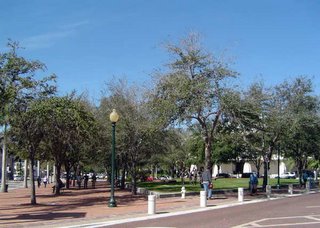The following article appears in the current issues of
Urban Land Institute.The article is extensive and gives many suggestions for improving tree cover in municipalities. The City and County of Sarasota have taken steps toward protecting and preserving our trees. Even though we have lost significant tree cover in the last decades, we can reverse this trend.
Urban Land - November/December 2005 - Feature
Reclaiming Trees
by John E. Cutler
The failure to adequately protect and care for public trees is resulting in a staggering loss of urban forests.
In the last few years, a 300-year-old historic live oak in San Antonio, Texas, was cut down on a hill that was leveled for a Lowe’s Home Improvement Warehouse, and 200 acres in another part of town were clear cut by another developer for a mixed-use project.
Indiscriminate tree cutting can often mean higher energy consumption for nearby residents and businesses, an increased threat of flooding during storms, and worsened air pollution. Tree removal sometimes can actually lessen a developer’s profits, because trees mean higher property values.
Some municipal governments also clear cut trees with little thought about the future. This past September, 83 large trees in Tracy, California, were chopped down for a new civic center that will be constructed on the site.
Then there are the utility companies. Centerpoint Energy in Houston, for example, has stated its plan to cut down 57 of 81 live oaks on one block of Newcastle Drive, reflecting its policy of removing anything in its
transmission corridors that might grow over ten feet in height.
Centerpoint Energy’s policy is the rule, not the exception, in the United States.
Nowadays, urban trees—particularly the large mature ones that have survived the rapid development of the last few decades—face a new threat: infill redevelopment. Such redevelopment may involve the expansion of an existing house, or the demolition of a smaller home and construction of a larger residence on the same lot.
Or it can mean the demolition of a smaller commercial structure and the construction of a much bigger building on its lot.
“Heritage trees on smaller lots are subject to an increasing threat of removal by the new real estate building trends,” says Dave Dockter, a city of Palo Alto, California, planning arborist. “Trees are ill-protected by obsolete ordinances that didn’t envision this [infill] development trend.”
As real estate development continues across the country, and as many jurisdictions fail to adequately protect and care for public trees, the scale of loss of the nation’s urban forests—the trees along streets, in parks, on business campuses, at civic buildings and schools, and in the yards of private residences—is staggering.
A recent study conducted by the nonprofit Washington, D.C.–based American Forests conservation organization of 448 urban areas in the United States found that the number of America’s urban trees declined by 21 percent over the last ten years. Denver has only a 25 percent tree canopy, while both Boston and Washington, D.C., have a 22 percent tree cover. Milwaukee has an 18 percent tree cover, with San Diego having only 13 percent. American Forests recommends a 40 percent average tree canopy for urban areas: 15 percent in commercial districts, 25 percent in urban residential neighborhoods, and 60 percent in suburban areas.
Meeting the American Forests organization’s recommendation, however, is a daunting task. If the United States wants to increase its total tree cover by just 10 percent, for instance, it will have to plant and maintain 1.7 billion new trees.
According to the American Forests study of urban areas, if the United States had maintained the tree canopy that existed in the early 1990s, it would have saved $234 billion over the last decade just from avoiding the environmental and health costs discussed above.
Urban forests are threatened by disease, neglect, vandalism—and development. But the ordinances and landscape codes that are supposed to protect trees often do not. Many jurisdictions frequently grant variances to tree ordinances and landscape codes to developers and companies, allowing them to cut down mature trees, almost continuously. This past September, for example, a grove of mature pine trees was demolished in Hartford, Connecticut, to make way for a small restaurant/retail complex. Some jurisdictions “protect” greenfield sites by requiring new developments to keep 10 percent of the existing trees—everything else faces the bulldozer and chainsaw.
Also, many municipalities are easily swayed by developers. In Shelby, Michigan, for instance, a contractor complained about the city’s requirement that all the trees on his project sites be inventoried, which would have cost him $25,000. In addition, the contractor could pass that cost on to his clients and their homebuyers, because mature trees mean higher property values. But the township waived the requirement anyway.
Most jurisdictions that do require developers to replace any trees they cut down, do not require exact replacements, but rather “equivalent” replacements. For example, a mature 15-inch-caliper tree can be
replaced by three five-inch-caliper trees, or by five three-inch caliper trees. But their small size prevents them from replicating the full air pollution, stormwater management, heat island mitigation, and property value benefits of the single mature tree.









 The
The  The
The 


